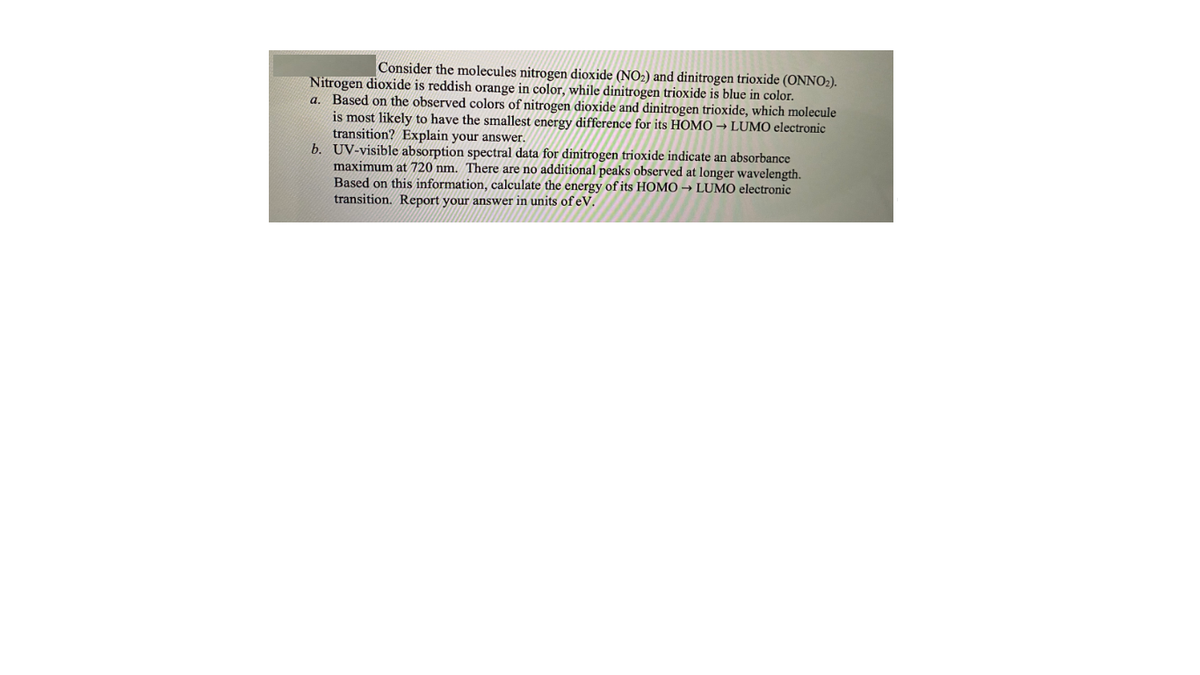Consider the molecules nitrogen dioxide (NO2) and dinitrogen trioxide (ONNO2). Nitrogen dioxide is reddish orange in color, while dinitrogen trioxide is blue in color. a. Based on the observed colors of nitrogen dioxide and dinitrogen trioxide, which molecule is most likely to have the smallest energy difference for its HOMO → LUMO electronic transition? Explain your answer. b. UV-visible absorption spectral data for dinitrogen trioxide indicate an absorbance maximum at 720 nm. There are no additional peaks observed at longer wavelength. Based on this information, calculate the energy of its HOMO → LUMO electronic transition. Report your answer in units of eV.
Consider the molecules nitrogen dioxide (NO2) and dinitrogen trioxide (ONNO2). Nitrogen dioxide is reddish orange in color, while dinitrogen trioxide is blue in color. a. Based on the observed colors of nitrogen dioxide and dinitrogen trioxide, which molecule is most likely to have the smallest energy difference for its HOMO → LUMO electronic transition? Explain your answer. b. UV-visible absorption spectral data for dinitrogen trioxide indicate an absorbance maximum at 720 nm. There are no additional peaks observed at longer wavelength. Based on this information, calculate the energy of its HOMO → LUMO electronic transition. Report your answer in units of eV.
Organic Chemistry
8th Edition
ISBN:9781305580350
Author:William H. Brown, Brent L. Iverson, Eric Anslyn, Christopher S. Foote
Publisher:William H. Brown, Brent L. Iverson, Eric Anslyn, Christopher S. Foote
Chapter20: Dienes, Conjugated Systems, And Pericyclic Reactions
Section: Chapter Questions
Problem 20.48P
Related questions
Question
Question is attached

Transcribed Image Text:Consider the molecules nitrogen dioxide (NO2) and dinitrogen trioxide (ONNO2).
Nitrogen dioxide is reddish orange in color, while dinitrogen trioxide is blue in color.
a. Based on the observed colors of nitrogen dioxide and dinitrogen trioxide, which molecule
is most likely to have the smallest energy difference for its HOMO → LUMO electronic
transition? Explain your answer.
b. UV-visible absorption spectral data for dinitrogen trioxide indicate an absorbance
maximum at 720 nm. There are no additional peaks observed at longer wavelength.
Based on this information, calculate the energy of its HOMO → LUMO electronic
transition. Report your answer in units of eV.
Expert Solution
This question has been solved!
Explore an expertly crafted, step-by-step solution for a thorough understanding of key concepts.
Step by step
Solved in 2 steps

Knowledge Booster
Learn more about
Need a deep-dive on the concept behind this application? Look no further. Learn more about this topic, chemistry and related others by exploring similar questions and additional content below.Recommended textbooks for you

Organic Chemistry
Chemistry
ISBN:
9781305580350
Author:
William H. Brown, Brent L. Iverson, Eric Anslyn, Christopher S. Foote
Publisher:
Cengage Learning


Physical Chemistry
Chemistry
ISBN:
9781133958437
Author:
Ball, David W. (david Warren), BAER, Tomas
Publisher:
Wadsworth Cengage Learning,

Organic Chemistry
Chemistry
ISBN:
9781305580350
Author:
William H. Brown, Brent L. Iverson, Eric Anslyn, Christopher S. Foote
Publisher:
Cengage Learning


Physical Chemistry
Chemistry
ISBN:
9781133958437
Author:
Ball, David W. (david Warren), BAER, Tomas
Publisher:
Wadsworth Cengage Learning,